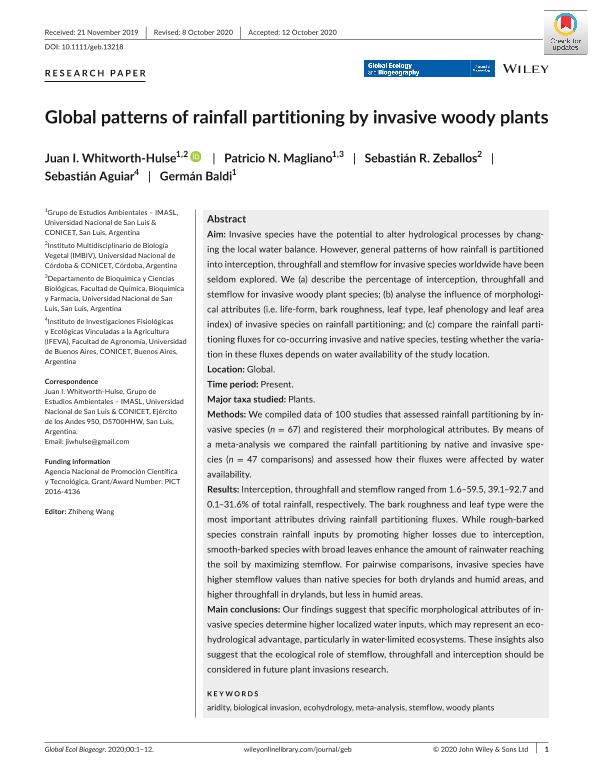Mostrar el registro sencillo del ítem
dc.contributor.author
Whitworth Hulse, Juan Ignacio

dc.contributor.author
Magliano, Patricio Nicolás

dc.contributor.author
Zeballos, Sebastián Rodolfo

dc.contributor.author
Aguiar, Sebastián

dc.contributor.author
Baldi, Germán

dc.date.available
2021-10-06T00:56:54Z
dc.date.issued
2020-11
dc.identifier.citation
Whitworth Hulse, Juan Ignacio; Magliano, Patricio Nicolás; Zeballos, Sebastián Rodolfo; Aguiar, Sebastián; Baldi, Germán; Global patterns of rainfall partitioning by invasive woody plants; Wiley Blackwell Publishing, Inc; Global Change Biology; 30; 1; 11-2020; 1-12
dc.identifier.issn
1354-1013
dc.identifier.uri
http://hdl.handle.net/11336/142799
dc.description.abstract
Aim: Invasive species have the potential to alter hydrological processes by changing the 7 local water balance. However, general patterns of how rainfall is partitioned into 8 interception, throughfall and stemflow for invasive species worldwide have been 9 seldom explored. We (a) describe the percentage of interception, throughfall and 10 stemflow for the invasive woody plant species; (b) analyse the influence of 11 morphological attributes (i.e., life-form, bark roughness, leaf type, leaf phenology and 12 leaf area index) of invasive species on rainfall partitioning; and (c) compare the rainfall 13 partitioning fluxes for co-occurring invasive and native species, testing whether these 14 fluxes variation depends on water availability of the study location. 15Location: Global. 16Time period: Present. 17Major taxa studied: Plants. 18Methods: We compiled data of 100 studies that assessed rainfall partitioning by 19 invasive species (N=67) and registered their morphological attributes. By means of a 20 meta-analysis we compared the rainfall partitioning by native and invasive species 21 (N=47 comparisons) and assessed how their fluxes were affected by water availability. 22Results: Interception, throughfall and stemflow ranged from 1.6 - 59.5%, 39.1 - 92.7% 23 and 0.1 - 31.6% of total rainfall, respectively. The bark roughness and leaf type were the 24 most important attributes driving rainfall partitioning fluxes. While rough-barked 25 species constrain rainfall inputs by promoting higher losses due to interception, smooth-26 barked species with broadleaves enhance the amount of rainwater reaching the soil by 27 maximizing stemflow. For pair-wise comparisons, invasive species have higher 28 stemflow values than native species for both drylands and humid areas, and higher 29 throughfall in drylands, but less in humid areas. 30Main conclusions: Our findings suggest that specific morphological attributes of 31 invasive species determine higher localized water inputs, which may represent an 32 ecohydrological advantage, particularly in water-limited ecosystems. These insights 33also suggest that the ecological role of stemflow, throughfall and interception should be 34 considered in future plant invasions research. 3536
dc.format
application/pdf
dc.language.iso
eng
dc.publisher
Wiley Blackwell Publishing, Inc

dc.rights
info:eu-repo/semantics/openAccess
dc.rights.uri
https://creativecommons.org/licenses/by-nc-sa/2.5/ar/
dc.subject
BIOLOGICAL INVASION
dc.subject
META-ANALYSIS
dc.subject
ECOHYDROLOGY
dc.subject
STEMFLOW
dc.subject
WOODY PLANTS
dc.subject
ARIDITY
dc.subject.classification
Otras Ciencias de la Tierra y relacionadas con el Medio Ambiente

dc.subject.classification
Ciencias de la Tierra y relacionadas con el Medio Ambiente

dc.subject.classification
CIENCIAS NATURALES Y EXACTAS

dc.title
Global patterns of rainfall partitioning by invasive woody plants
dc.type
info:eu-repo/semantics/article
dc.type
info:ar-repo/semantics/artículo
dc.type
info:eu-repo/semantics/publishedVersion
dc.date.updated
2021-09-07T13:49:54Z
dc.journal.volume
30
dc.journal.number
1
dc.journal.pagination
1-12
dc.journal.pais
Reino Unido

dc.journal.ciudad
Londres
dc.description.fil
Fil: Whitworth Hulse, Juan Ignacio. Consejo Nacional de Investigaciones Científicas y Técnicas. Centro Científico Tecnológico Conicet - San Luis. Instituto de Matemática Aplicada de San Luis "Prof. Ezio Marchi". Universidad Nacional de San Luis. Facultad de Ciencias Físico, Matemáticas y Naturales. Instituto de Matemática Aplicada de San Luis "Prof. Ezio Marchi"; Argentina. Consejo Nacional de Investigaciones Científicas y Técnicas. Centro Científico Tecnológico Conicet - Córdoba. Instituto Multidisciplinario de Biología Vegetal. Universidad Nacional de Córdoba. Facultad de Ciencias Exactas Físicas y Naturales. Instituto Multidisciplinario de Biología Vegetal; Argentina
dc.description.fil
Fil: Magliano, Patricio Nicolás. Consejo Nacional de Investigaciones Científicas y Técnicas. Centro Científico Tecnológico Conicet - San Luis. Instituto de Matemática Aplicada de San Luis "Prof. Ezio Marchi". Universidad Nacional de San Luis. Facultad de Ciencias Físico, Matemáticas y Naturales. Instituto de Matemática Aplicada de San Luis "Prof. Ezio Marchi"; Argentina. Universidad Nacional de San Luis. Facultad de Química, Bioquímica y Farmacia. Departamento de Bioquímica y Ciencias Biológicas; Argentina
dc.description.fil
Fil: Zeballos, Sebastián Rodolfo. Consejo Nacional de Investigaciones Científicas y Técnicas. Centro Científico Tecnológico Conicet - Córdoba. Instituto Multidisciplinario de Biología Vegetal. Universidad Nacional de Córdoba. Facultad de Ciencias Exactas Físicas y Naturales. Instituto Multidisciplinario de Biología Vegetal; Argentina
dc.description.fil
Fil: Aguiar, Sebastián. Consejo Nacional de Investigaciones Científicas y Técnicas. Oficina de Coordinación Administrativa Parque Centenario. Instituto de Investigaciones Fisiológicas y Ecológicas Vinculadas a la Agricultura. Universidad de Buenos Aires. Facultad de Agronomía. Instituto de Investigaciones Fisiológicas y Ecológicas Vinculadas a la Agricultura; Argentina
dc.description.fil
Fil: Baldi, Germán. Consejo Nacional de Investigaciones Científicas y Técnicas. Centro Científico Tecnológico Conicet - San Luis. Instituto de Matemática Aplicada de San Luis "Prof. Ezio Marchi". Universidad Nacional de San Luis. Facultad de Ciencias Físico, Matemáticas y Naturales. Instituto de Matemática Aplicada de San Luis "Prof. Ezio Marchi"; Argentina
dc.journal.title
Global Change Biology

dc.relation.alternativeid
info:eu-repo/semantics/altIdentifier/doi/https://doi.org/10.1111/geb.13218
dc.relation.alternativeid
info:eu-repo/semantics/altIdentifier/url/https://onlinelibrary.wiley.com/doi/epdf/10.1111/geb.13218
Archivos asociados
